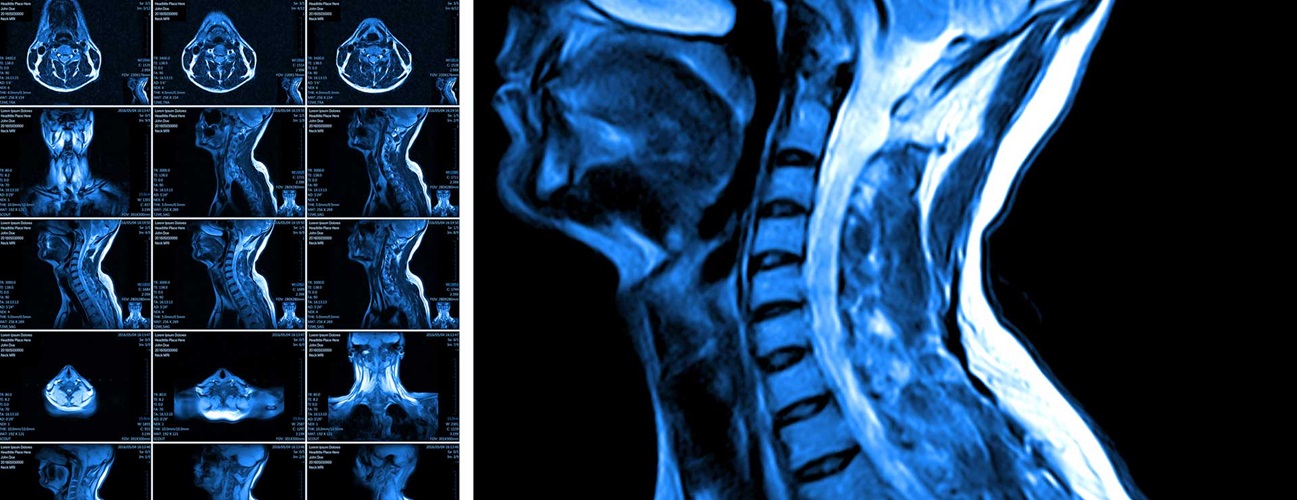Cervical Myelopathy
What You Need to Know
- Cervical myelopathy results from compression of the spinal cord in the neck (cervical area of the spine).
- Symptoms of cervical myelopathy may include problems with fine motor skills, pain or stiffness in the neck, loss of balance, and trouble walking.
- MRI scans are the preferred diagnostic method for cervical myelopathy, but other methods can also be used to help rule out other conditions.
- Cervical myelopathy is best treated with spine decompression surgery.
What is cervical myelopathy?
Cervical myelopathy is a form of myelopathy that involves compression of the spinal cord in the cervical spine (neck). Your cervical spine contains seven vertebrae (C1 to C7), with six intervertebral discs and eight nerve roots. The spinal cord travels inside the vertebral column constructed from the front by vertebrae, cushioned by the intervertebral discs, and from the back by the facet joints and lamina. In the cervical spine, eight nerve roots branch out that primarily control the function of your shoulders, arms and hands.
Symptoms of Cervical Myelopathy
Cervical myelopathy produces two types of symptoms: the ones you may feel in the neck, and the ones appearing elsewhere in the body at or below the compressed area of the spinal cord.
The neck symptoms may include:
-
Neck pain
-
Stiffness
-
Reduced range of motion
As the disease progresses, one may experience shooting pain that originates in the neck and travels down the spine.
Other cervical myelopathy symptoms may include:
-
Weakness in the arms and hands
-
Numbness or tingling in the arms and hands
-
Clumsiness and poor coordination of the hands
-
Difficulty handling small objects, like pens or coins
-
Balance issues
Is neck pain a sure sign of cervical myelopathy?
Many people experience neck pain, but not all neck pain can be traced back to cervical myelopathy. Some patients with this condition don’t have any neck pain at all. The cause of your neck pain could be muscular rather than neurological. Talk to your doctor if you are suffering from persistent neck pain.
Cervical Spondylotic Myelopathy
One common type of cervical myelopathy is cervical spondylotic myelopathy. The term “spondylotic” refers to one of the possible causes of myelopathy — gradual degeneration of the spine that happens as you age. Therefore, cervical spondylotic myelopathy is more common in people 50 and older.
The gradual degeneration of the spine often takes the form of cervical spinal stenosis, which is the narrowing of the spinal canal in the neck. Some people are born with a narrow spinal canal (congenital spinal stenosis) and may experience myelopathy sooner than others if further narrowing occurs. Bulging or herniated discs and bone spurs in the neck are other forms of spinal degeneration that can press on the spinal cord and cause myelopathy.
Other Causes of Cervical Myelopathy
Besides the gradual wear and tear of the spine, cervical myelopathy can also be caused by the ossification (hardening) of the ligaments surrounding the spinal cord, such as posterior longitudinal ligament and ligamentum flavum.
The ossification of posterior longitudinal ligament (OPLL) is more common. This means that the soft tissue that connects the bones of the spinal column becomes less flexible and slowly turns into bone (ossification). As the ligament becomes thicker, it starts taking up more space and putting pressure on the spinal cord, which leads to myelopathy. The neck portion of the spine is the most common location for OPLL ossification.
Other causes of cervical myelopathy may include:
-
Rheumatoid arthritis of the neck
-
Whiplash injury or other cervical spine trauma
-
Spinal infections
-
Spinal tumors and cancers
Cervical Myelopathy Diagnosis
The earlier cervical myelopathy is diagnosed, the more successful the treatment is expected to be. However, cervical myelopathy symptoms are not unique to this condition and are often mistaken for “normal” signs of aging.
To diagnose cervical myelopathy, your doctor may:
-
Conduct a physical examination and measure your muscle strength and reflexes.
-
Conduct further tests, including an MRI scan, an X-ray or a CT myelogram of your neck.
-
Conduct electrical tests to measure how well the nerves in your arms and hands communicate with your brain through the spinal cord.
Cervical Myelopathy Treatment
There are some nonsurgical options for relieving cervical myelopathy symptoms, including physical therapy and a cervical collar brace. However, to eliminate the compression of the spinal cord and prevent worsening of the condition, surgery is often necessary.
There are a few surgical procedures your doctor may recommend for treating cervical myelopathy. Widening of the spinal canal (laminoplasty) can be a good motion-sparing option for some patients. Others may benefit from spine decompression surgery with spinal fusion, which is meant to stabilize the spine after herniated discs, bone spurs or ossified ligaments are fully or partially removed.
These surgeries can be performed from the back of the neck (posteriorly) or from the front of the neck (anteriorly). Your doctor will recommend a specific surgery approach based on your situation.






